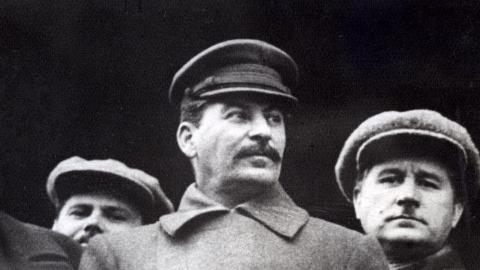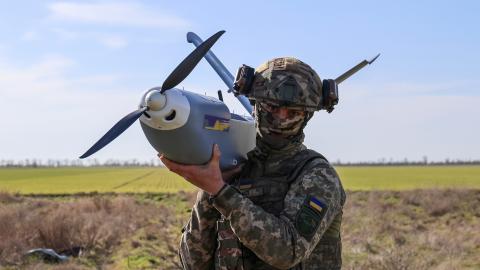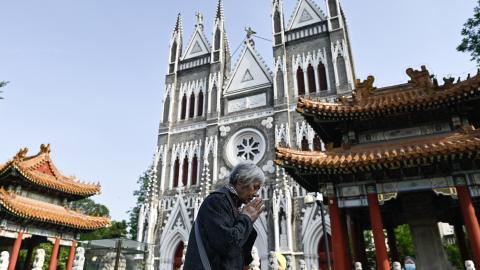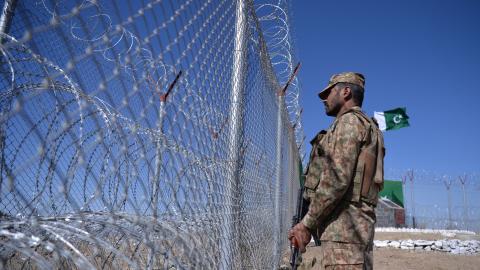Lashkar-e-Tayyaba (LeT), more commonly known as Jamaat ud Dawa (JuD) in Pakistan, is well known for its military assistance to the Pakistan Army by conducting terrorist attacks in India and Afghanistan.1 What is less commonly understood is the organization’s ideological support that it lends to the army. In this essay, we analyze a 2018 Urdu-language book titled Jamaat ud Dawa’s Role Against Terrorism by Ameer Hamza, a principle LeT ideologue. The book is a compilation of his previously published columns as well as several articles written by his wife. We dilate upon Hamza’s writings here.
Hamza organizes his articles in this volume around three central themes. First, the author vigorously advocates his support for the Pakistani military, often phrasing it in explicitly Islamic terms to paint the Pakistani military as the “Army of Allah.” Second, Hamza’s intellectual work counters any drift, however partial, towards a stable political process and media freedoms. It paints political leaders and some journalists as part of a corrupt mafia, eager to protect their wealth by serving the interests of Pakistan’s—and Islam’s—enemies, including India and the United States. Third, it depicts the anti-military Islamist groups—of which there are many in the region—as Kharejis, using religious violence to serve the interests of Pakistan’s and Islam’s enemies. Finally, Hamza turns his attention to Pakistan’s external foes.
In this essay, we first provide a brief history of LeT/JuD. Subsequently, we explain who Ameer Hamza is and why his opinions are significant in the context of LeT/JuD. Third, we exposit the main themes of the volume mentioned previously: Support for the military, arguments against Pakistan’s political leaders, arguments against other Islamist groups, and arguments against Pakistan’s foreign adversaries (ostensibly including the United States).
We conclude this essay with a discussion of the volume’s wider implications. Namely, we discuss the ways in which the arguments of this book advance the interests of Pakistan’s army itself and mirror the army’s own narratives. Consistent with the Pakistan army’s worldview, the list of Pakistan’s ostensible internal and external foes detailed by Hamza overlap. The Pakistan Army has long argued that its domestic challenges are due to conspiratorial efforts of India as well the United States and West.2
What is the Lashkar-e-Tayyaba?
Although the exact year in which Lashkar-e-Tayyaba (LeT, meaning “Army of the Righteous”)3 coalesced is unknown,4 scholars generally contend that it began in the late 1980s. During that period, the Ahl-e-Hadees Islamist militant Zaki-ur-Rehman Lakhvi gathered several Pakistani Ahl-e-Hadees5 adherents to wage jihad against the Soviets in Afghanistan.6 Separately, Hafiz Muhammad Saeed and Zafar Iqbal, two professors from the Islamic studies department of Lahore Engineering University, founded Jamaat ud Dawah (JuD) around 1985. JuD, the “Organization for Preaching,” was initially a small group engaged in tabligh (proselytization) and dawah (missionary work) with the intent of promulgating the Ahl-e-Hadees creed. Around 1986, Lakhvi’s LeT amalgamated with Saeed and Iqbal’s JuD to form the Markaz al-Dawah-wal-Irshad. This combined organization, the “Center for Preaching and Guidance” (MDI), had three preoccupations: jihad; proselytization of the Ahl-e-Hadees maslak (Islamic interpretive tradition), and the creation of a new generation of Muslims committed to their ideology.7
Within a year of its formation, MDI established its first militant training camp, Muaskar-e-Taiba, in the Afghan province of Paktia in eastern Afghanistan. It established another camp, Muaskar-e-Aqsa, in Kunar, which abuts the Pakistani tribal agencies of Bajaur and Mohmand in what was then known as Pakistan’s Federally Administered Tribal Areas (FATA).8 After the Soviets withdrew from Afghanistan in 1989, MDI reoriented its militant efforts toward Indian-administered Kashmir because the group wanted to distance itself from the internecine infighting among different so-called jihadi groups in the Afghanistan-Pakistan region. MDI relocated its training facilities to Pakistani-administered Kashmir where it established numerous camps in the mountains. The organization’s decision to eschew warlord infighting partly reflects MDI’s preference to abjure Muslim-on-Muslim violence. The decision also reflects its belief that Kashmir is the most legitimate open front for jihad in the region and indicates that MDI entered the fray there before it became Pakistan’s proxy of choice.9
MDI’s headquarters (Markaz) was built in 1989 on a 200-acre campus in Muridke in Pakistan’s Punjab province, some 30 kilometers from Lahore. Punjab, unlike the FATA, is one of the most militarized provinces in Pakistan. Of the nine regular Pakistan Army corps, six are in Punjab alongside the Army Air Defense Command and Strategic Forces Command, which are treated as corps. The MDI Markaz, which is now the headquarters for JuD, hosts numerous amenities and businesses, including a madrasa (seminary), large jamia mosque, hospital, market, large residential area for scholars and faculty members, garment factory, iron factory, woodworking factory, stable, swimming pool, fish farm, and agricultural tracts.10
On January 25, 1990, MDI staged its first militant mission in Kashmir when its operatives ambushed a jeep that was carrying Indian Air Force personnel traveling toward Srinagar airport, killing one squadron leader and three pilots.11 In the early 1990s, MDI segmented its activities and organizational structure. While MDI continued the mission of proselytization and education, it hived off LeT as a tightly related militant wing of MDI.12 However, Hafiz Saeed was the leader (emir) of both organizations, which attests to the degree to which it was nearly impossible to distinguish MDI and LeT.13 Hafiz Saeed explained the continuity between the two organizations as follows: “Islam propounds both dawah and jihad. Both are equally important and inseparable. Since our life revolves around Islam, therefore both dawah and jihad are essential; we cannot prefer one over the other.”14
Pakistan’s intelligence agency, the Inter-Services Intelligence (ISI), had hoped that LeT, with its demonstrable lethal capabilities,15 would intensify the conflict in Kashmir and expand the geographical reach of the insurgency. In the early 1990s, the ISI and the Pakistan Army began providing support to the organization. The army helped build LeT’s military apparatus specifically for use against India, as opposed to Afghanistan, Chechnya, or other theatres of international jihad where LeT activists periodically fought. The Pakistan Army helped design the organization’s military training regime and has long co-located army and ISI personnel at LeT training bases to help oversee the regimen.16 Pakistan’s investments paid off: within a few years, LeT became the biggest challenge to the Indian security forces in Kashmir, prior to the 2000 introduction of the Jaish-e-Mohammad (JeM), a brutal Deobandi Kashmir-oriented terrorist group.17
In December 2001, Pakistan officially banned LeT, along with several other militant groups, after JeM attacked the Indian parliament, bringing India and Pakistan close to the brink of war. These bans deceived no one. Pakistan’s intelligence agencies alerted the soon-to-be banned organizations of the upcoming proscription, providing them ample time to transfer their assets to new accounts and to reorganize and re-launch under new names. In the case of LeT, Hafiz Saeed announced the organization had been restructured and would operate as JuD, separate from LeT, with the latter being a strictly Kashmiri organization led by Maula Abdul Wahid al-Kashmiri. Saeed dissolved MDI and replaced it with JuD, which was the name of the original organization he had founded in 1985 and which was still registered as a Pakistani charity. He resigned as LeT’s emir and became the emir of JuD, which was described as an “organization for the teaching of Islam, politics, [and] social work.”18 Yahya Mujahid, spokesperson for LeT-cum-JuD and one of the founding members of MDI, announced that “We handed Lashkar-e-Tayyaba over to the Kashmiris in December 2001. Now we have no contact with any jihadi organization.”19 This purported division was merely a reorganization: JuD subsumed the vast majority of LeT’s human, financial, and material assets while the organizational nodes and operatives outside of Pakistan continued to serve under the banner of LeT. As further evidence of the organizational continuity between the various groups, Hafiz Saeed, Zafar Iqbal, Hafiz Abdul Rehman Makki, and Zaki-ur-Rehman Lakhvi oversaw the new organization while al-Kashmiri was merely a figurehead.20
Curiously, the US government did not recognize JuD as a Foreign Terrorist Organization (FTO) until December 2001, reflecting American indifference to it. Washington only did so after JEM’s attack on India’s Parliament in December of that year, which had precipitated the largest Indian military mobilization along the Pakistani border since the 1971 war. Both to preclude an Indo-Pakistani war and re-concentrate Pakistani focus towards its Afghan border, where NATO military operations were just commencing, Washington spent considerable political capital persuading India to stand down. As a part of these diplomatic efforts, the United States proscribed LeT and JeM among other Pakistan-based and Pakistan-backed terrorist organizations. At the same time, the administration of President George W. Bush pressured Pakistan’s military dictator and president, General Pervez Musharraf, to ban LeT and other organizations that Washington had designated. Washington also pressured Musharraf to make a series of public statements aimed at mitigating Indian concerns and even persuaded him to curtail sending terrorists into India for some time after the 2001 parliament attack.21 While Musharraf may have conceded to Washington on some issues, the bans were a farce.
JuD has been part of several umbrella organizations with other Pakistani militant groups as well as non-militant, right-of-center political groups. For example, in January 2009, JuD was involved in a group called the Tehreek-e-Tahafuz Qibla Awal (Movement for the Safeguarding of the First Center of Prayer), which held anti-Israel protests in Lahore.22 Similarly, in 2010, JuD had a noticeable presence in the Tehreek-e-Tahafuz-e-Hurmat-e-Rasool (“Movement to Defend the Honor of the Prophet”), which organized protests against the Danish cartoons of the Prophet Muhammad. Later in 2012, JuD was prominent in the Difa-e-Pakistan Council (“Defense of Pakistan Council”), which organized large rallies in Lahore, Rawalpindi, Karachi, and elsewhere to protest American policies in Pakistan as well as U.S.-International Security Assistance Force (ISAF) activities in Afghanistan. In the spring of 2015, JuD also generated popular support for Pakistani military assistance to the Saudi-led coalition in Yemen. To do so, JuD formed the Pasban-e-Harmain-Sharifain (“Defenders of the Sacred Sites in Mecca and Medina”) and argued that the Yemeni Houthi rebels aimed to invade Saudi Arabia and assault the harmain—the Grand Mosque in Mecca—and the Prophet’s Mosque in Medina.23
In August 2017, JuD opened a new front when it formed a political party named the Milli Muslim League (MML, the “National Muslim League”) with the aim of rendering Pakistan a “real Islamic and welfare state.”24 While Saeed initially said that this party was separate from JuD this ultimately proved to be fiction, like many of his other pronouncements. Upon Saeed’s release from “house arrest” in late November 2017, the MML leadership opined, “Mr. Hafiz Saeed will soon start planning out our membership strategy and getting others on board through networking.”25 Saeed dropped the façade in early December when he announced that JuD is “planning to contest the 2018 general elections under the banner of Milli Muslim League.”26 The MML, headed by Saifullah Khalid, a close aide of Saeed and a foundational member of JuD, fielded several candidates in the 2018 general election but won no races.
Who is Amir Hamza?
Amir Hamza, the author of the 2018 book Jamaat ud Dawa’s Role Against Terrorism, is a core member of LeT/JuD and a member of the central committee of their mother organization, the MDI. He is considered to be a top LeT/JuD ideologue and is described by observers as a fiery speaker and prolific writer.27
He is said to have led JuD's fundraising campaigns and negotiated with authorities for the release of JuD leaders arrested over the years. He is the founding editor of JuD's official publications, including the weekly Jarrar. In a 2012 report, the U.S. Department of Treasury provided details about his career, noting that:
"As of 2011, Amir Hamza, a member of LeT's central advisory committee, actively maintained LeT's relationships with other groups under the direction of LeT emir Hafiz Muhammad Saeed. Hamza has led an LeT-associated charity and, as of 2010, was also an officer and member of an LeT university trust that was led by Saeed. Hamza's responsibilities as of mid-2010 also included publishing propaganda on behalf of LeT. Hamza has served as editor of an LeT weekly newspaper and, as of mid-2011, he was contributing articles to the LeT publication. Hamza was also one of three LeT leaders to negotiate the release of detained LeT members as of mid-2010. Hamza served as the head of LeT's "special campaigns" department as of mid-2009."28
In the beginning of Jamaat ud Dawa’s Role Against Terrorism, Hamza describes himself as a widely traveled person, having traveled to Afghanistan several times, the last being after the withdrawal of the Soviet forces. He also claims to have “traveled to Uzbekistan, Kazakhstan, Turkmenistan, Azerbaijan, Moscow and Astrakhan, and then wrote a travelogue. He also went to Saudi Arabia, Turkey, Iran, Oman, United Arab Emirates, Bangladesh, Sri Lanka, and the Maldives, and wrote books about those travels.” He further describes himself as “one of Pakistan’s prominent newspaper columnists […] writing regular columns for daily 29
According to the book:
"Maulana Amir Hamza cites facts and events to prove that that the Pakistan Army is the strongest army in the world. He also revealed to the enemy that apart from defending the geographical and ideological borders of the country, the Pakistan Army also represented the desires and dreams of the entire Islamic world. It is the army of Islam as embodied by its motto “faith, piety, and jihad in the name of God.” It will never let its enemies fulfill their desire to cause damage to Pakistan. He accomplished this mission by visiting the homes of the martyred soldiers, speaking to their families, and bringing forth those families’ sentiments regarding Islam and jihad. Likewise, he penned credible material about the Khareji ideology and its links to terrorism. These are the two subjects on which the present book is based."30
This volume is thus important because it bears the imprimatur of LeT/JuD’s inner-most circle and reflects the thinking of one of the group’s principal ideologues and propagandists.
JuD Narratives on The Army and Pakistan’s “Foes” at Home and Abroad
Hamza’s columns compiled in this book exposit several themes that undergird LeT’s support for the Pakistani military, widely using quotations from the Quran and Sunna (sayings of the Prophet) to paint it explicitly as the Army of God. The author also uses religious quotes and moral themes to ideologically counter the country’s meager drift towards a stable political process and media freedoms. Hamza paints political leaders and some journalists as part of a corrupt mafia, eager to protect their wealth by serving the interests of Pakistan’s—and by extension Islam’s—enemies, including India and the United States. In a subsequent section, Hamza portrays the anti-military Islamist groups—or Kharejis—as using religious violence to serve the interests of Pakistan’s and Islam’s enemies, just as politicians and secular-minded journalists do. Finally, Hamza describes Pakistan’s external foes. The reader will note that that there is considerable overlap in the internal and external foes because the Pakistani state sees a foreign hand behind the activities of its internal enemies.
The Army of Allah
In his writing, Amir Hamza aims to ensure that the entire population of the country is supportive of the military so as to secure the future of Pakistan. One example is a speech he delivered at a JuD gathering in May 2014 and which he quotes in his column:
"And praise be to God, I made an announcement there that every Pakistani needed to become a symbolic minister of defense, and that we will train every child of the country to that effect, so that they can step in time with the army, and when their combined fist of self-defense lands on the terrorists, we could see [Narendra] Modi falling flat on his face."31
The book opens with a column paying tribute to General Ziaul Haq, Pakistan’s second military dictator (1977–1988), who toppled the country’s first elected government and is widely seen as the main driving force behind the Islamization of Pakistan and the subsequent evolution of its jihadist-based militant strategies in Afghanistan and India. Here, Hamza claims that it was General Zia who founded the South Asian Association for Regional Cooperation (SAARC) with an aim to weaken India.32 He writes, “I salute the vision of General Ziaul Haq who brought together the countries of the sub-continent in the SAARC organization, and thereby compelled India, which considers itself as the mini super-power of the region, to stand down as an equal with (smaller) countries like Nepal, Maldives, Sri Lanka, Bhutan and Bangladesh.”33 In subsequent articles included in the book, Hamza also explores the “divine” traits of the Pakistani soldiers, providing “physical” as well as “intellectual” evidence of their supposedly godly character.
Physical stature of Pakistani soldiers
Hamza seeks to buff the physical stature of the Pakistan Army. This is perhaps considered important given that Pakistan has started each of its wars with India and failed to win any of them. In the 1971 war, it lost half of its population when East Pakistan seceded and became independent Bangladesh with India’s assistance. In one column originally published in December 2016 and included in the book, Hamza gathers quotes from the Bible and the Quran to explain how, with his 12-foot-tall stature, the pious King Saul of Bani-Israel was able to overcome and defeat 10-foot-tall Goliath, the leader of the polytheists.34 This, he writes, happened despite the fact that Saul hailed from a humble background as compared to Goliath, and despite the fact that his people were not confident in his strength and acumen.35
Hamza next applies this divine logic to the “Saul-like” army chiefs of Pakistan, listing among them General Raheel Sharif, whose term as the Chief of Army Staff (COAS) had just ended at the time of writing in 2016, and the then-newly inducted army chief, General Qamar Javed Bajwa, whom he describes as the tallest of them all, with a height of six-foot-four-inches. Hamza contrasts General Bajwa to the then-Prime Minister Nawaz Sharif, using coarse language to discredit the latter. He does this by describing scenes in several pictures taken after General Bajwa’s induction as COAS, in which the two men are shown standing together, looking at each other. Nawaz Sharif, he writes:
"[Is] looking at Qamar Bajwa in the same way as one would look at the moon and stars in the sky. It is understandable. Gen. Qamar is so tall that a man of middle-height like Nawaz Sharif will have to bend his head up in order to look at him. On his part, Gen. Qamar Bajwa looks at the man in front of him just as someone standing on the terrace will look at someone down in the street.”36
Hamza then extends the comparison to Indian soldiers and the daily parades that take place at the Wagah border-crossing between India and Pakistan. He writes of the parade:
"[While Pakistani soldiers] rise to six and a quarter foot, those of India come up to just five and a half feet. At times, it has happened that an Indian soldier fell to the ground because one of our tall and broad-shouldered soldiers banged his foot down on the ground in full force. During the parade, when our soldier lifts his foot, it rises higher than the Indian soldiers’ chests, or even their heads. And when the Indian soldier lifts his foot, it only goes up to the height of our soldiers’ hips."37
Prophetic traits of soldiers
Hamza attributes to Pakistan’s soldiers various prophetic traits, enhancing their spiritual stature in addition their physical stature. For example, in a February 2015 piece titled “Military Intellectuals and Today’s Politicians,” Amir Hamza spins a dramatic tale of how a senior military officer and former ISI chief, General Akhtar Abdur Rahman, had predicted the December 1991 break-up of Soviet Union as early as in 1976. He claims that General Rahman shared his prophecy with a LeT preacher and ideologue, Asadullah Ghalib, after the end of a farewell ceremony of a retiring officer that both of them had attended.
He writes:
"Brig. Akhtar Abdur Rahman38 holds Asadullah Ghalib’s hand and tells him, “We are faced with an ignoble enemy (India) who cannot tolerate our existence. The problem is that he is not alone in attacking us; a super-power, Russia, is standing behind him. Pakistan is being punished for being an Islamic country. The real fun will start when this enemy confronts us directly.” Mr. Ghalib is slightly confused, and asks him, “a confrontation with Russia? How?” Brig. Rahman replies that there will be a direct confrontation with Russia; there will be a clash. Russian intentions are not hidden from anyone. It wants to have access to warm waters. From the era of the Tsars till the age of its new communist monarchs, they have always craved for access to the Arabian Sea. Afghanistan is their short cut to achieve this aim, and they will send their troops there sooner or later. And this is where it will get trapped in a conflict so serious that keeping itself in one piece will become hard despite all of its nuclear and military strength."39
Amir Hamza narrates another story to prove a saying attributed to the Prophet Mohammad that the earth will never eat up the body of a martyr—meaning that a martyr’s body will never decay or decompose. Hamza says he came across this story while sitting around a winter fire with some retired soldiers working as security guards in his neighborhood. During a chat, he quotes one soldier as telling him:
"[T]here is a military graveyard in Bedyan area on the outskirts of Lahore, where martyrs from the wars of 1965 and 1971 are buried. Some days ago, we had to bury a soldier there who had recently died. My name was on the list of grave diggers. As I was digging the grave, I accidentally discovered a human body down there. My hoe hit one of its wrists and blood started sprouting from it like a spring. I tried to stop it with my hand but failed. Finally, we called a doctor from a nearby village who bandaged the slashed part to stop the blood flow."40
The column continues:
"Dear readers! I was listening to him, and wondering, if the body was that of a martyr from 1965, it would be 50 years old. If it was from 1971, then it was 44 years old. Whether 50 or 44, the body was nearly half a century old anyways, and yet it was still fresh and oozing blood. Obviously, this blood is that of a prince of God’s paradise, where billions of residents and all the angels know him and are aware of his exalted status."41
In another column published soon after the retirement of COAS General Raheel Sharif in November 2016, he demonstrates how the newly inducted army chief, General Qamar Javed Bajwa, has been treading in the path of the Holy Prophet. He starts with a conversation of the Holy Prophet, quoted in the compilation titled Tirmizi Sharif: “Once a man walked up to the Prophet, and said, ‘O Prophet of God, I have committed a grave sin; is there any room for forgiveness?’ The Prophet asked, ‘Is your mother alive?’ He said, ‘no.’ The Prophet said, ‘do you have an aunt (mother’s sister)?’ He said yes. The Prophet said, ‘be kind to her, and your sins will be forgiven’.”42 Then Hamza turns directly to the topic of General Bajwa:
"Dear readers, soon after being inducted as the army chief, Gen. Bajwa went to his mother’s grave, raised his hands in prayers, and wept. Then, from the graveyard, he headed to the house of his maternal aunt, Safia Begum. She doesn’t have any children of her own. So, whenever Gen. Bajwa called on her, he would invariably convey to her the impression that he was her child. And so, after his mother’s death, she also took the place of his mother. While my Holy Sire (Prophet Mohammad) granted a paternal uncle the status of a father, He also granted an aunt the place of a mother. So, the first thing Gen. Bajwa did after becoming the army chief was to go and pay his respects to relations with an exalted status."43
Hamza’s conclusive description of the character of army officers comes in one column, where he writes that an army general “is a creature of God, an heir of the martyrs, having an honest heart and a straight tongue; he believes in action, considers state’s assets as a trust of the nation, and tries to live within the means of his monthly salary. Most of all, he believes in God, and humbly requests his interlocuters to remember him in their prayers.”44 It should be noted that Pakistan’s military does not describe its own soldiers in these ways. Thus, in a sense, Hamza is filling a propaganda niche that the army has left vacant.
Pakistan’s Internal Foes
Because the army fiercely protects its primacy in the ostensibly civilian-led government, the army conflates its own domestic enemies with those of Pakistan. This tendency is evidenced in this volume in which Amir Hamza identifies several internal foes: politicians, journalists, and Kharejis and Takfiris, all of whom oppose the military’s role in Pakistan’s politics. We discuss each theme in turn.
Politicians
In a clear contrast to army officers, the book paints politicians as a driving force behind the social, political, economic, and security problems that the army is trying to bring under control. Those heading larger political parties are painted as a corrupt, self-serving mafia focused on personal gains, thereby compromising national interests. And those representing different regions of the country—particularly the restive and insurgency-prone provinces of Khyber Pakhtunkhwa and Balochistan—are painted as anti-Pakistan.
As mentioned previously, the columns reproduced in the book were written during the period when the chief of the Pakistan Muslim League-Nawaz (PML-N),45 Nawaz Sharif, was the country’s prime minister. Consequently, he is the most consistent target in these columns, although Hamza does not spare other leaders such as Asif Zardari and Bilawal Bhutto of the Pakistan Peoples’ Party (PPP).46 The main narrative contrasts political corruption with the sacrifices made by the army and how this has led the army to supposedly rise above the politicians in terms of popularity.
One example is a column published in September 2015, in which Hamza describes the scene at a gathering following the oath-taking ceremony of the country’s new chief justice, Anwar Zaheer Jamali. He writes “As soon as the oath-taking ended and tea-party started, all the people present there gathered around Army Chief, General Raheel Sharif. The prime minister [Nawaz Sharif] was also present there, but nobody went to him. His own ministers and governors also joined the crowd around the COAS. When Nawaz Sharif saw this, he thought it would be better to leave. So, he left promptly, without taking tea.” The column further adds; “The tragic part is that this event has flung his popularity from heavens to Earth, and the sound of the crash has shaken my heart.”47
Why did this happen? It happened because, as Hamza sees it, the politicians care more for their “stomachs” than the safety and well-being of the nation. He writes in one column: “The Holy Prophet once said that the stomach was the worst of all bags. Today’s politicians are busy filling this foul-smelling bag, while those who are sacrificing their lives to save Pakistan are none other than army soldiers.”48
Hamza also examines how politicians are supposedly responsible for the rise of terrorism in the country. In one January 2015 column titled “The Prophet’s Love for Martyrs’ Children,” Hamza is extremely critical of PPP leader Asif Zardari as well as PML-N chief Nawaz Sharif for continuing with a moratorium on the death penalty which had been signed by Mr. Zardari when he had been president back in 2008.49 Human rights advocacy groups within the country had demanded the moratorium, citing flaws in the system that allowed powerful circles to manipulate the judiciary.50
Advocating in favor of the death penalty for terrorists following the December 2014 attack on Peshawar’s Army Public School that killed more than 150 people (mostly school children), Hamza writes:
"Pakistan’s legal system has totally collapsed. Criminals continue to practice terrorism; when judges convict them, they kill those judges; when imprisoned, they break jails or use threats to avail facilities inside jail and thereby continue their business of bloodshed via their operatives in the field. They were further facilitated when in return for a few pennies worth of trade agreement,51 former president Asif Ali Zardari put a moratorium on executions. Mian Nawaz Sharif has continued that policy… Yes sir! Such cooperation by the state has helped murderers and terrorists to further accelerate their activities. The rulers have security cordons around them, but the common people and their children don’t have it, and so they are the ones who are being killed."52
In a December 2017 column titled “Drift of Military and Today’s Politicians,” Hamza focuses on so-called anti-Pakistan politicians, and how Nawaz Sharif has started to drift in their direction after he was disqualified by the Supreme Court in July of that year.53 In a dramatic sequence, the column first mentions a quote from a Nawaz Sharif’s speech and then discloses where the speech was delivered. The quote from the speech says, “a prime minister has been sacked; such are the decisions that destroy countries, that create anarchy and confusion, and thereby undermine the nation’s sense of its intended destiny.”54 He then reveals to the readers that Sharif “expressed these thoughts at a public meeting organized in Quetta by a nationalist party led by Mehmood Khan Achakzai.” Hamza continues:
"The meeting was held to mark the death anniversary of Abdus Samad Achakzai,55 a political and ideological friend of Abdul Ghaffar Khan,56 known as the Frontier Gandhi. It was presided by Mehmood Achakzai, the son of Abdus Samad Achakzai. So, nowadays, Mian Nawaz Sharif is propagating his ideas from the platforms of the people who were opposed to the creation of Pakistan; people who were causing troubles to Quaid-e-Azam [Mohammad Ali Jinnah]."57
This is an allusion to the fact that Abdul Ghaffar Khan opposed joining Pakistan and advocated for the Northwest Frontier Province to join India.
Journalists
A central theme of all the columns in the book is the need to counter the secular, anti-military sentiment that was arising at the time. The rise of independent reporting and analysis, which started with the return of democracy in 1988, had by then started to expose the secretive terror and business interests of the military.58 In most cases, such reports were published without directly naming the military, but they did add to the mass perception of how the military was using backdoor channels to influence political decision-making.
Most of the columns included in this volume that focus on Pakistani media and journalists build a narrative to support the military’s evolving strategies to influence and control the media.59 Among other tactics, the military at the time was accused of using its terrorist proxies to eliminate journalists who could potentially damage the military’s image in the public’s eye.
The opening column in the book, titled “Fashion and the Army,” was published on May 7, 2014, against a backdrop of an unprecedented wave of attacks on journalists. At least seven news reporters were killed in attacks by armed militants in 2013, according to international advocacy group Reporters Sans Frontièrs (RSF), while many others were injured. Among the latter was Raza Rumi, a well-known columnist and television anchor associated with the Express Media Group. Rumi had emerged as an authentic analyst of the Pakistani politico-security landscape and a frontline critic of the ideology promoted by the military establishment. Armed militants attacked his car on March 28, 2014, killing his driver and causing many injuries to Rumi.60 A mere three weeks later, on April 19, Geo TV’s most popular talk-show host, Hamid Mir, was attacked and suffered severe bullet wounds. Like Raza Rumi, he was an outspoken critic of the military, its intelligence services, as well as of the judiciary, which he said was harming the political establishment and thereby creating room for the military to protect its political and economic interests. Soon after the attack, Mir’s brother, also a journalist, quoted him as saying that the attack was part of an assassination plan hatched by the ISI.61 This claim was repeatedly aired by Geo TV and also picked up by other media outlets, thereby damaging the public image of the military. In response, military-promoted religious groups started to pour out onto the streets in all the major urban centers of the country, chanting pro-military slogans, expressing their love for the army and ISI, demanding the cancellation of Geo’s license, and calling on the media network to issue an apology.62 While the country’s media regulator, Pakistan Electronic Media Regulatory Authority (PEMRA), put Geo TV off the air at that time, the decision apparently came from quarters beyond the control of the elected government of Nawaz Sharif, who, on his part, was among the first political leaders to visit Hamid Mir in the hospital to express his sympathies.63
In one column, Hamza weaves a long tail of the threats Pakistan faces from hostile forces and the sacrifices rendered by the army to protect the Pakistani people from those threats. He then writes:
"But on the other side, our own people have started condemning our defenders. There are certain “patriots” in the mainstream media who never mention occupied Kashmir and the violent suppression of its innocent Muslims by the Indian army. They never see how the Gulfams and Ayeshas of Kashmir are pricked and plucked and killed by the Indian army. They just look for a chance to assault the army with taunts and catcalls. It is said that these patriots are pocketing sizeable benefits from America."64
He then compares those journalists to the “real patriots”—the male and female religious activists who staged demonstrations against Geo TV at that time, raising posters that carried pictures of then-army chief General Raheel Sharif and then-ISI chief Lt. Gen. Rizwan Akhtar. He writes, “So, these are the circumstances in which patriots have walked onto the scene so as to challenge those people.”65 While it is impossible to know how readers have received these writings, rhetorically, they help delegitimize the press’s attacks on the military and firmly characterize Pakistan’s anti-military media as domestic enemies to be countered.
Kharejis and Takfiris
Due to events explained further below under the title “Pakistan’s External Foes,” by the 2010s, Deobandi Islamist groups once raised and equipped by the Pakistani military had broken into factions, and many of them had turned against Pakistan and its army. Perhaps the most important example of this is the Pakistani Taliban (Tehreek-e-Taliban-e-Pakistan, or TTP). Since these groups were raised in the name of Islam, Hamza uses numerous quotes from the Quran and Prophet Mohammad to establish how they had transgressed the principles of Islamic faith.
He defines such groups as Kharejis (extremists who also use Takfir) and Takfiris (those who declare other sects as apostates and frequently kill them) on the grounds that “when they plan an attack, they launch it on Muslims. When they chose a target, it is either a mosque, a school or an institution that defends Muslims. They attack women and children.”66
He supports his claim in the same column by interpreting a saying of the Prophet according to his own perception:
"According to a saying of the Prophet, quoted by Ibn-e-Maja, “the Kharejis are the dogs of hell.” The way I see it in the light of this saying, their faces will transform into faces of dogs, and they will enter the hell barking. But since they believe in Kalima (Muslim statement of faith), the question that arose in my mind was, why is God so harsh on them. The answer I received was, because when they kill, they only kill Muslims. When they bark, it’s only on the believers of Kalima. And therefore, their punishment will be the severest of all."67
In another column published in March 2016, he follows up on this theme in the context of the killing of four Pakistani soldiers by TTP militants in a clash in the Waziristan region: “And while the Khareji narrative terms all the people linked to the security forces, and even their children, as Satans, the message from God is that theirs is the holy blood, spilled on the path of righteousness. The message from Pakistan’s four provinces is also the same, that they will fight terrorists. Hence, victory belongs to these uniformed men, on earth as well as in the heavens.”68
Regarding militant attacks on non-Muslims in Pakistan, he writes: “There is a saying of the Prophet that ‘guard yourself against the curse of the oppressed, even if the oppressed is not a Muslim.’ Yes sir. Muslim or no Muslim, he is still a creature of God. God is the creator of the world, and does not tolerate maltreatment of anyone, whether a believer or a non-believer.”69 This argument is consistent with LeT’s more general position against violence committed against Pakistanis or in Pakistan, as articulated in his manifesto Hum Jihad Kyon Kar Rahe Hain.70This puts LeT in start contrast to the various sectarian groups that target religious minorities as well as other Muslims due to their sectarian commitments.
Pakistan’s External Foes
In this volume, Hamza primarily identifies and dilates upon two external foes: India and the United States (and the West more broadly). This may come as a surprise to many given the substantial military and non-military assistance the United States has given Pakistan in recent decades. Between financial year 2002 and 2022, the United States gave Pakistan $8.4 billion in military assistance, nearly $11.9 billion in economic assistance, and $14.6 billion to the Coalition Support Fund (created after the September 11 attacks to support Pakistani counterterrorism operations) for a grand total of $34.9 billion.71
India
Amir Hamza penned the opening column of the book, “Fashion and The Army,” on May 7, 2014, the day general elections were held in India. Modi’s Bharatya Janata Party (BJP) won those elections, and he was tipped to be the next Prime Minister of India at the time of Hamza’s writing. In the column, Hamza reminds his readers that as Chief Minister of Gujrat province in 2002, Modi “burnt to death 5,000 Muslims in his provincial capital, Ahmadabad, by sprinkling oil on them” in reference to the anti-Muslim riots that Modi tolerated (or actively stoked, according to some testimonies). According to Hamza, when asked if he felt sorry for Muslim deaths, “he replied that he felt just as sorry as when his car overran a dog.”72
While appreciating Pakistan’s military ruler, General Ziaul Haq, for creating SAARC and thereby compelling India to behave as an equal with the smaller states of South Asia (noted previously), the writer builds a narrative of how Modi exacted his revenge against Pakistan. Hamza writes, without providing credible evidence,73 that India was behind the assassination of Nepal’s King Burendra and his family in 2001. This was because, according to Hamza, “King Burendra loved Pakistan despite being a Hindu and had issues with India.” 74 Hamza also claims, with greater evidentiary basis, that India “helped Sheikh Hasina Wajid become Bangladesh’s prime minister for the third time—the same Hasina Wajid who had banned the waving of Pakistani flags in the sports stadiums because they had started emitting hot air for her.” Hamza continues, “India has also provided triggers for Buddhist-Muslim clashes in Sri Lanka, which has come very close to Pakistan because of Gen. Zia’s efforts. And now, India has started playing a role in Afghanistan, with which it shares neither a border nor faith. And from there, it is sending its agents to launch attacks on our armed forces.”2 It should be noted that each of these claims have quite varying degrees of empirical underpinnings. While India’s posited role in Burendra’s assassination has little evidentiary support, India was indeed a staunch supporter of Sheikh Hasina’s continued premiership and did intervene in 2024 to support her onward tenure.76 Indian involvement in Afghanistan is well known, even if the extent of India’s involvement is debatable.77
In a September 2016 column titled “War, Despite Avoiding War,” Hamza is writing in the aftermath of an attack carried out by militants on an Indian army base in the Uri region of Indian Kashmir.78 In response to this Pakistani provocation, the Indian Air Force carried out “surgical strikes” on suspected militant hideouts on Pakistani side of the region.79 In the column, Hamza blames Pakistan’s Prime Minister, Nawaz Sharif, for his peace overtures to India, which Hamza claims were viewed in India as Pakistani weakness. Hamza opines that, “We flew around our ‘doves of peace’ [an Urdu idiom] so much that Prime Minister Nawaz Sharif even invited Modi to the wedding of his granddaughter, and also sent him a gift of sarees for his mother.” 80 The author claims that this hospitality was not reciprocated. Hamza further criticizes Nawaz Sharif because he “even went to the extent of ordering the lodging of a criminal case in Gujranwala against the perpetrators of the Pathankot attack,”81 which the author sees as another effort at rapprochement towards an arrogant and unbending Modi. Hamza accuses Modi of exhibiting politeness and humility only for the sake of maintaining a tactical peace. But by issuing his exaggerated war threats, Modi only proves that he is truculent, trouble-monger.82
Hamza also blames India for the rise of violence in the Pashtun and Baloch regions. He writes: “This [Indian-backed] war is being fought on the ideological as well as the media front. The sad part is that India has been able to avail the services of not only the gun carrying fighters (Pakistani Taliban, TTP), but also proxy ideologues and media platforms within Pakistan.”83
The United States and the West
Throughout the successive columns published in the book, Hamza promotes a narrative that India is fomenting terrorism in Pakistan with the help of the United States and the West more broadly. Their purported aim is to rid Pakistan of its nuclear power by breaking up the country along ethnic lines. He writes that this Indian policy has continued since the time that “the Americans decided to leave Afghanistan and hand the region over to India.” But since the whole world “knows that Pakistan Army has become unbeatable, India is only waging a proxy war at the moment. And it recruits its proxies from within Pakistan…”84 This is a clear reference to the anti-state militant groups in Pakistan, with Hamza further elaborating that “attacks on Pakistan’s defense institutions are launched by these same Kharejis, and India is behind them. These Kharejis set up their sanctuaries in Afghanistan, which means that they enjoy American support.”85
Hamza extends this conspiratorial mindset that sees Western support behind militancy to several other parts of the Muslim world. For example, he claims in another column published in November 2016:
"During his recent visit to Pakistan, Turkish President, Recep Tayyip Erdoğan, also disclosed in clear terms that the West was behind Daesh,86 which was carrying out terror attacks in Turkey. The ill-fated suicide bomber who recently attacked the Holy Abode of Medina has also been found to be linked to the same Khareji group. Similarly, a missile attack launched on Mecca from the side of Yemen, which the Saudi air force successfully countered by destroying the missile in the air some 65 kilometers away from Mecca, was also launched by the Khareji group of Houthi rebels."87
Relatedly, in a September 2015 column, Hamza builds an anti-American narrative in the context of America’s reported request to establish a military base in Deosai plains in the Gilgit-Baltistan region of Pakistan.88 He writes:
"I was lost in my thoughts, thinking about America which often spoke about being a friend of ours. During the September (1965) war,89 it continued to assure us that India will restrict the fight to Kashmir and will never cross the international border. But in secret parleys with India, it had already planned that India will attack Lahore and Sialkot. During the era of Gen. Ziaul Haq, the same America backed India to capture Siachen,90 where a limited war between Pakistan and India has continued for several years. Almost every unit of our army has gone through the experience of confronting the enemy in Siachen. On the other hand, the duplicitous America is asking Pakistan to let it set up an airbase in Deosai, so that it can keep a close watch over China. How can Pakistan keep throwing its axe on its own feet by handing its vast and most beautiful earthen “roof” to an enemy disguised as a friend, so that he could create problems for Pakistan’s bosom buddy, China."91
LeT’s depiction of the United States is widely shared by the Pakistani military as well as Pakistanis more generally. In a 2012 Pew Poll (the most recent conducted), 74% of Pakistanis viewed the United States as an enemy compared to 8 percent who viewed it as a partner.92 As seen in Hamza’s quote above, from the Pakistani military’s point of view, the United States evinced its duplicity as early as 1962 when the United States aided India—Pakistan’s archnemesis—in its war against China. Then again in 1965, the United States cut off assistance to Pakistan as well as India due the outbreak of hostilities between the two countries; however, Pakistan was dependent upon the United States for military maintenance and supplies whereas India was not. This sentiment deepened when the United States sanctioned Pakistan for nuclear-proliferation-related concerns after the Soviets withdrew from Afghanistan and Pakistan was no longer needed as a security partner.93
Conclusion
This volume offers important insights into the ways in which LeT promotes narratives that support the Pakistan Army. Prior to the identification and translation of this volume, scholarship on the relationship between LeT and the army focused upon the way in which LeT contributes to Pakistan’s grand strategic objectives, with Pakistan relaying on militants to execute its foreign policy objectives.94 Hamza’s book also advances the military’s objectives in domestic politics, as Hamza goes to great lengths to bolster the Pakistani army’s image during a period when Pakistan’s media and public began to criticize the army. This volume’s arguments about the pious and Islamic nature of the Pakistan Army may be more even more important in contemporary Pakistan as the army is under relentless criticism for its persecution of the highly popular politician, Imran Khan.95 Second, Hamza’s volume identifies Pakistan’s (ostensible) internal and external foes. It should be noted that LeT’s identification is very similar to that of the Pakistan Army, thus legitimizing the arguments of the latter. Domestically, these enemies include journalists, political parties, as well as the militants attacking Pakistan’s armed forces. Externally, LeT refers to India and the United States and the “West” more generally. Consistent with the Pakistan Army’s understanding, Pakistan’s internal and external enemies are intertwined in LeT’s telling. The Pakistani army has long propounded the theory that India, the United States, and the West are engaged in a wide array of conspiracies to undermine Pakistan through brutal proxies.96 As such, Hamza’s book provides invaluable insights for scholars who are looking for answers as to why Pakistan feels the need to sustain religious militants such as LeT.



















